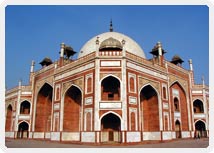+91 858 886 6045
Delhi Attractions
Akshardham TempleLotus TempleQutub MinarRed FortJama MasjidRaj GhatPurana QilaNational ZooChandni ChowkJantar MantarHumayuns TombHz. NizamuddinLodhi GardenPragati MaidanPresident HouseIndia GateParliament HouseNational MuseumCrafts MuseumISKCON TempleLaxmi Narayan TempleTughlakabad FortHumayuns Tomb

This is the mausoleum of Humayun, second Mughal Emperor of India. It was built by his widow Biga Begum (Hajji Begum) in 1569-70, 14 years after his death. This was the first garden-tomb on the Indian subcontinent designed by the Persian architect Mirak Mirza Ghiyath.
This tomb is also the first Indian architecture in which red sandstone used at a large-scale. It was declared as an UNESCO World Heritage Site in 1993 because of its historical importance and architectural beauty. The mausoleum also houses the graves of Hamida Begum (Akbar's mother), Dara Shikoh (Shah Jahan's son) and Bahadur Shah II, the last Mughal Emperor.
The tomb is located in the middle of a geometrically arranged garden based on the concept of char baah (four-fold) style with pools joined by channels. The designed of this mausoleum is based on an Islamic idea that the paradise or jannat is a place set somewhere in the middle of the garden with water flowing through it.
The tomb sits at the center of a plinth about 7 meters high. The central dome reaches 140 feet from the ground. The dome is design in a double-layered with the outer layer with white marble and ornate interior design. The rest of the tomb is decorated in red sandstone with white marble decoration.
Visiting Time
Open from sunrise to sunset
Entrance Fee
Citizens of India and visitors of SAARC (Bangladesh, Nepal, Bhutan, Sri Lanka, Pakistan, Maldives and Afghanistan) and BIMSTEC Countries (Bangladesh, Nepal, Bhutan, Sri Lanka, Thailand and Myanmar) - Rs. 10 per head.
Others: US $ 5 or Indian Rs. 250/- per head
Free entry for children up to 15 years
Tajmahal Tours
Golden Triangle India
- Golden Triangle with Corbett
- Golden Triangle with Goa
- Golden Triangle with Kathmandu
- Golden Triangle with Wildlife
- Indian Heritage Tour with Tajmahal
- Buddhist Pilgrimage with Golden Griangle Tour
- Golden Triangle Tour
- Golden Triangle Tour with Haridwar and Rishikesh
- Golden Triangle with Khajuraho Varanasi
- Golden Triangle with Kashmir
- Tajmahal with Pushkar Fair
Delhi Tourism
Jaipur Tourism
Agra Tourism
Golden Triangle Extension
- Ranthambhor National Park
- Khajuraho Tourism
- Varanasi Tourism
- Rishikesh Tourism
- Haridwar Tourism
- Corbett Wildlife Sanctuary
- Mathura Travel
- Vrindavan Travel
- Gwalior Travel
Activities to Do


Copyright © 2020, www.tajmahal-india-tours.com
Recognized by Ministry of Tourism, Government of India
National Tourism Award Winner
Powered by SOFTTIX

